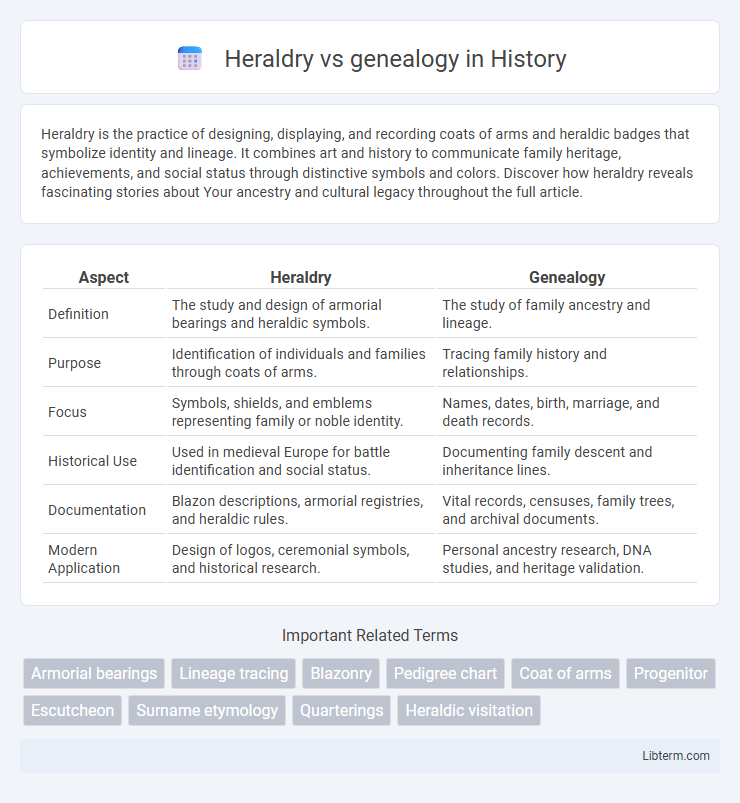Heraldry is the practice of designing, displaying, and recording coats of arms and heraldic badges that symbolize identity and lineage. It combines art and history to communicate family heritage, achievements, and social status through distinctive symbols and colors. Discover how heraldry reveals fascinating stories about Your ancestry and cultural legacy throughout the full article.
Table of Comparison
| Aspect | Heraldry | Genealogy |
|---|---|---|
| Definition | The study and design of armorial bearings and heraldic symbols. | The study of family ancestry and lineage. |
| Purpose | Identification of individuals and families through coats of arms. | Tracing family history and relationships. |
| Focus | Symbols, shields, and emblems representing family or noble identity. | Names, dates, birth, marriage, and death records. |
| Historical Use | Used in medieval Europe for battle identification and social status. | Documenting family descent and inheritance lines. |
| Documentation | Blazon descriptions, armorial registries, and heraldic rules. | Vital records, censuses, family trees, and archival documents. |
| Modern Application | Design of logos, ceremonial symbols, and historical research. | Personal ancestry research, DNA studies, and heritage validation. |
Understanding Heraldry: Symbols and Significance
Heraldry involves the study and design of coats of arms and heraldic symbols used to represent individuals, families, or institutions, emphasizing colors, shapes, and motifs that convey identity and lineage. Unlike genealogy, which traces family history and ancestral relationships through records and DNA evidence, heraldry focuses on visual symbolism that communicates heritage, social status, and achievements. Understanding heraldry requires knowledge of specific elements such as shields, crests, mantling, and badges, each carrying unique meanings tied to tradition and historical context.
What is Genealogy? Tracing Family Roots
Genealogy is the study of tracing family roots and lineage through historical records, documents, and oral histories to establish connections between ancestors and descendants. It involves analyzing birth, marriage, and death certificates, census data, and immigration records to construct detailed family trees. Unlike heraldry, which focuses on coats of arms and symbols, genealogy prioritizes documenting personal and familial relationships across generations.
Origins and Historical Development
Heraldry originated in the 12th century as a system for identifying knights and noble families through distinctive coats of arms, evolving into a formalized art and science with strict rules of design and symbolism. Genealogy, with roots in ancient civilizations like Mesopotamia and Egypt, developed as the study and documentation of family ancestries and lineages, preserving historical records and heritage across generations. While heraldry emphasizes visual representation and social status, genealogy focuses on tracing biological descent and familial connections over time.
Key Differences Between Heraldry and Genealogy
Heraldry primarily studies coats of arms, symbols, and emblems used to identify individuals, families, or institutions, while genealogy focuses on tracing family lineages and ancestral relationships through historical records and DNA analysis. Heraldic research emphasizes the design, rules, and meanings of armorial bearings, whereas genealogical research concentrates on documenting family history and constructing family trees. The distinct purposes highlight heraldry's visual identification role and genealogy's historical lineage reconstruction.
How Heraldry Complements Genealogical Research
Heraldry enhances genealogical research by providing visual symbols that represent family lineage, helping to authenticate and distinguish ancestral connections. Coats of arms and heraldic emblems serve as historical identifiers, often revealing relationships and social status that written records alone might not capture. Incorporating heraldic data into genealogical studies offers a multidimensional understanding of family histories and ancestral heritage.
Heraldic Symbols and Their Meanings
Heraldic symbols, such as shields, crests, and charges, serve as visual representations of identity, lineage, and social status within heraldry. Each element, including colors like azure (blue) symbolizing loyalty and gules (red) denoting warrior strength, conveys specific meanings that help distinguish families and individuals. These symbols are codified through heraldic traditions, providing a structured language that contrasts with genealogy's detailed ancestral records and family history documentation.
Tools and Resources for Genealogists
Genealogists utilize specialized software platforms such as AncestryDNA, MyHeritage, and Family Tree Maker to build and verify family lineages through extensive databases and DNA analysis. Online archives, including national census records, birth and death certificates, and immigration documents, serve as critical resources for authenticating ancestral connections. Collaborative platforms and historical societies further enhance genealogical research by providing access to expert knowledge and community-driven data verification.
Using Coats of Arms in Family History
Using coats of arms in family history provides a visual symbol that represents ancestral identity and lineage, often linked to heraldry's formal system of designing and regulating armorial bearings. Heraldry focuses on the symbolic design and legal rules governing coats of arms, while genealogy traces family lineage and relationships through historical records and DNA analysis. Incorporating coats of arms into genealogical research enriches the family narrative by connecting documented ancestors with their heraldic emblems, enhancing the understanding of heritage and social status across generations.
Common Misconceptions About Heraldry and Genealogy
Heraldry is often mistaken for genealogy, but it primarily concerns the design, display, and study of armorial bearings, while genealogy focuses on tracing family lineages and ancestry. A common misconception is that possessing a coat of arms means direct descent from a noble ancestor, whereas many heraldic symbols were granted to individuals or institutions, not entire families. Genealogy relies on historical records and DNA evidence for lineage verification, whereas heraldry follows strict rules of symbolism and inheritance specific to heraldic authorities.
Choosing the Right Approach for Your Ancestral Research
Heraldry and genealogy serve distinct purposes in ancestral research, with heraldry focusing on the study of coats of arms, symbols, and family crests, while genealogy traces lineage and family history through documented records. Choosing the right approach depends on your research goals: heraldry offers insights into family identity and social status, whereas genealogy provides detailed ancestral lineage, birth, marriage, and death records. Combining both can enrich your understanding of heritage, but prioritizing genealogy ensures a comprehensive family tree foundation.
Heraldry Infographic

 libterm.com
libterm.com